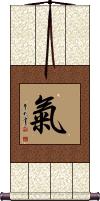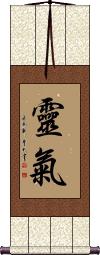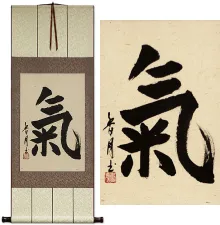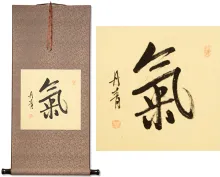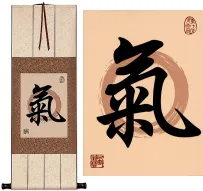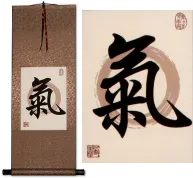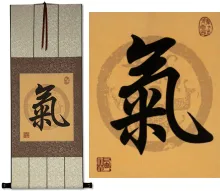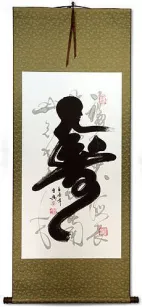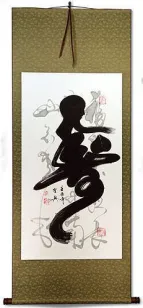Many custom options...
And formats...

Not what you want?
Try other similar-meaning words, fewer words, or just one word.
Spiritual Life in Chinese / Japanese...
Buy a Spiritual Life calligraphy wall scroll here!
Personalize your custom “Spiritual Life” project by clicking the button next to your favorite “Spiritual Life” title below...
Life Energy / Spiritual Energy
Chi Energy: Essence of Life / Energy Flow
This 氣 energy flow is a fundamental concept of traditional Asian culture.
氣 is romanized as “Qi” or “Chi” in Chinese, “Gi” in Korean, and “Ki” in Japanese.
Chi is believed to be part of everything that exists, as in “life force” or “spiritual energy.” It is most often translated as “energy flow” or literally as “air” or “breath.” Some people will simply translate this as “spirit,” but you must consider the kind of spirit we're talking about. I think this is weighted more toward energy than spirit.
The character itself is a representation of steam (or breath) rising from rice. To clarify, the character for rice looks like this: ![]()
Steam was apparently seen as visual evidence of the release of “life energy” when this concept was first developed. The Qi / Chi / Ki character is still used in compound words to mean steam or vapor.
The etymology of this character is a bit complicated. It's suggested that the first form of this character from bronze script (about 2500 years ago) looked like these samples: 

However, it was easy to confuse this with the character for the number three. So the rice radical was added by 221 B.C. (the exact time of this change is debated). This first version with the rice radical looks like this: 
The idea of Qi / Chi / Ki is really a philosophical concept. It's often used to refer to the “flow” of metaphysical energy that sustains living beings. Yet there is much debate that has continued for thousands of years as to whether Qi / Chi / Ki is pure energy or consists partially or fully of matter.
You can also see the character for Qi / Chi / Ki in common compound words such as Tai Chi / Tai Qi, Aikido, Reiki, and Qi Gong / Chi Kung.
In the modern Japanese Kanji, the rice radical has been changed into two strokes that form an X.
![]() The original and traditional Chinese form is still understood in Japanese, but we can also offer that modern Kanji form in our custom calligraphy. If you want this Japanese Kanji, please click on the character to the right instead of the “Select and Customize” button above.
The original and traditional Chinese form is still understood in Japanese, but we can also offer that modern Kanji form in our custom calligraphy. If you want this Japanese Kanji, please click on the character to the right instead of the “Select and Customize” button above.
More language notes: This is pronounced like “chee” in Mandarin Chinese, and like “key” in Japanese.
This is also the same way to write this in Korean Hanja where it is Romanized as “gi” and pronounced like “gee” but with a real G-sound, not a J-sound.
Though Vietnamese no longer use Chinese characters in their daily language, this character is still widely known in Vietnam.
See Also: Energy | Life Force | Vitality | Life | Birth | Soul
Spiritual Soul Mates
魂の伴侶 is a Japanese-only title for soulmates.
魂 means soul, spirit, immortal soul (the part of you that lives beyond your physical body), or the conscious mind. In the Buddhist context, this is vijñāna or viññāṇa (consciousness, life force, or mind).
の is a possessive article that connects everything here.
伴侶 means mates, companions, partners, and spouses.
Spiritual Peace / Enlightened Peace
These Japanese Kanji, 安心立命, can be translated as “religious enlightenment” or “spiritual peace gained through faith.”
Other dictionaries define as “spiritual peace and enlightenment” or “keeping an unperturbed mind through faith.”
My Buddhist dictionary defines it as “spiritual peace and realization of enlightenment.”
In the Zen school, this is about settling one's body and life; attaining complete peace, and establishing one's course of life in accord with the ultimate reality.
Energy Sword Body in Concert
Spirit, Sword & Body as One
气剑体一致 often gets translated as “Mind Sword Body,” or “Spirit, Sword, and Body as One.” But I think these translations don't tell you enough about what this is really saying.
In this context, 気, which is the modern Japanese version of 氣, means spiritual and unseen energy or “life energy.” In some cases, 気 can be translated as spirit, feeling, or nature. If defined as the mind, it's more about the invisible or intangible parts of one's mind (or soul).
剣 is the Japanese version of 劍 meaning sword.
体 is the modern Japanese version of 體 meaning body.
The Kanji 一 means one, and in this case, suggests “all in one.”
The Kanji 到 means to send, deliver, or convey. But together, 一到 suggests all these things in agreement, union cooperation, or in concert.
Note: Arguments exist as to whether this should be romanized as Kikentaiitchi, Kikentaiicchi, or kikentaiichi. Technically, if you drop the last character, you get 気剣体一 and kikentaiichi (ki ken tai ichi), which is also a valid phrase.
Reiki
靈氣 is the title of a healing practice now found globally but with origins in Japan.
Special note: Outside of the context of the healing practice of Reiki, this means “aura” or “spiritual essence that surrounds all living things.” A Japanese person unfamiliar with the practice will take the “aura” meaning.
Reiki is a technique for stress reduction and relaxation that also heals. It can be compared to massage but is based on the idea that an unseen “life force energy” flows through us and is what causes us to be alive. If your life force energy is low, you'll be more likely to get sick or feel stressed. If your life force energy is abundant and flowing well, you become more capable of being happy and healthy.
There is a lot of information available if you want to Google this term - my job is to offer the calligraphy while you can decide if it is right for you.
Note: We are showing the ancient (traditional) form of the Reiki Kanji. I have seen Reiki written with the slightly simplified version and this more classic form. If you want the form of Reiki with the two strokes in the shape of an X on the second character and the modern first character, simply click on the Kanji characters to the right.
Note: 靈氣 is also a Chinese word, but in Chinese, these characters create a word that refers to a smart person or someone with high aspirations. It is not read as a healing method in Chinese.
In Korean Hanja, this can be read as a “mysterious atmosphere” by a Korean who is not familiar with the practice of Reiki (still has a cool meaning in Korean).
This in-stock artwork might be what you are looking for, and ships right away...
Gallery Price: $61.00
Your Price: $33.88
Gallery Price: $300.00
Your Price: $109.88
Gallery Price: $31.00
Your Price: $16.88
Gallery Price: $72.00
Your Price: $39.88
Gallery Price: $90.00
Your Price: $49.88
Gallery Price: $65.00
Your Price: $39.88
Gallery Price: $90.00
Your Price: $49.88
Gallery Price: $61.00
Your Price: $33.88
Gallery Price: $61.00
Your Price: $33.88
Gallery Price: $61.00
Your Price: $33.88
Longevity / Long Life Unique Calligraphy Scroll
Discounted Blemished
Gallery Price: $47.00
Your Price: $26.00
Gallery Price: $61.00
Your Price: $33.88
Gallery Price: $31.00
Your Price: $16.88
Decorative Longevity / Long Life Calligraphy Wall Scroll
Discounted Blemished
Gallery Price: $31.00
Your Price: $17.00
Not the results for spiritual life that you were looking for?
Below are some entries from our dictionary that may match your spiritual life search...
| Characters If shown, 2nd row is Simp. Chinese |
Pronunciation Romanization |
Simple Dictionary Definition |
身 see styles |
shēn shen1 shen misaki みさき |
More info & calligraphy: Body(1) one's body; one's person; (2) oneself; one's appearance; (3) one's place (in society, etc.); one's position; (4) main part; meat (as opposed to bone, skin, etc.); wood (as opposed to bark); blade (as opposed to its handle); container (as opposed to its lid); (surname) Misaki kāya; tanu; deha. The body; the self.; Two forms of body; there are numerous pairs, e. g. (1) (a) 分段身 The varied forms of the karmic or ordinary mortal body, or being; (b) 變易身 the transformable, or spiritual body. (2) (a) 生身 The earthly body of the Buddha; (b) 化身 hinirmāṇakāya, which may take any form at will. (3) (a) 生身 his earthly body; (b) 法身 his moral and mental nature—a Hīnayāna definition, but Mahāyāna takes his earthly nirmāṇakāya as the 生身 and his dharmakāya or that and his saṃbhogakāya as 法身. (4) 眞應二身 The dharmakāya and nirmāṇakāya. (5) (a) 實相身 The absolute truth, or light, of the Buddha, i. e. the dharmakāya; (b) 爲物身 the functioning or temporal body. (6) (a) 眞身 the dharmakāya and saṃbhogakāya; (b) 化身 the nirmāṇakāya. (7) (a) 常身 his permanent or eternal body; (b) 無常身 his temporal body. (8) (a) 實身 and 化身 idem 二色身. |
三堅 三坚 see styles |
sān jiān san1 jian1 san chien sanken |
The three sure or certain things are 身, 命 and 財, i.e. the reward of the true disciple is an infinite body or personality, an endless life, and boundless (spiritual) possessions, 無極之身, 無窮之命, 無盡之財, v. 能摩經:菩薩品. |
三等 see styles |
sān děng san1 deng3 san teng santō さんとう |
third class The three equal and universal characteristics of the one Tathāgata, an esoteric definition: (1) (a) his 身 body, (b) 語 discourse, (c) 意 mind. (2) (a) his life or works 修行; (b) spiritual body 法身; (c) salvation 度生; in their equal values and universality. |
十妙 see styles |
shí miào shi2 miao4 shih miao jūmyō |
The ten wonders, or incomprehensibles; there are two groups, the 迹v traceable or manifested and 本門妙 the fundamental. The 迹門十妙 are the wonder of: (1) 境妙 the universe, sphere, or whole, embracing mind, Buddha, and all things as a unity; (2) 智妙 a Buddha's all-embracing knowledge arising from such universe; (3) 行妙 his deeds, expressive of his wisdom; (4) 位妙 his attainment of all the various Buddha stages, i.e. 十住 and十地; (5) 三法妙 his three laws of 理, 慧, and truth, wisdom, and vision; (6) 感應妙 his response to appeal, i.e. his (spiritual) response or relation to humanity, for "all beings are my children"; (7) 神通妙 his supernatural powers; (8) 說法妙 his preaching; (9) 眷屬妙 his supernatural retinue; (10) 利益妙 the blessings derived through universal elevation into Buddhahood. The 本門十妙 are the wonder of (1) 本因妙 the initial impulse or causative stage of Buddhahood; (2) 本果妙 its fruit or result in eternity, joy, and purity; (3) 國土妙 his (Buddha) realm; (4) 感應妙 his response (to human needs); (5) 神通妙 his supernatural powers; (6) 說法妙 his preaching; (7) 眷屬妙 his supernatural retinue; (8) 涅槃妙 his nirvāṇa; (9) 壽命妙 his (eternal) life; (10) his blessings as above. Both groups are further defined as progressive stages in a Buddha's career. These "wonders" are derived from the Lotus sūtra. |
心命 see styles |
xīn mìng xin1 ming4 hsin ming shinmyō |
Mind life, i. e. the life, longevity, or eternity of the dharmakāya or spiritual body, that of mind; also 慧命. v. 智度論 78. |
慧命 see styles |
huì mìng hui4 ming4 hui ming e myō |
Wisdom-life, or wisdom as life, wisdom being the basis of spiritual character. A term of address to a monk, also 慧壽, and to a monk by a superior. |
比丘 see styles |
bǐ qiū bi3 qiu1 pi ch`iu pi chiu biku びく |
Buddhist monk (loanword from Sanskrit "bhiksu") bhikkhu (fully ordained Buddhist monk) (san: bhiksu) 比呼; 苾芻; 煏芻 bhikṣu, a religious mendicant, an almsman, one who has left home, been fully ordained, and depends on alms for a living. Some are styled 乞士 mendicant scholars, all are 釋種 Śākya-seed, offspring of Buddha. The Chinese characters are clearly used as a phonetic equivalent, but many attempts have been made to give meanings to the two words, e. g. 比 as 破 and 丘 as 煩惱, hence one who destroys the passions and delusions, also 悕能 able to overawe Māra and his minions; also 除饉 to get rid of dearth, moral and spiritual. Two kinds 内乞 and 外乞; both indicate self-control, the first by internal mental or spiritual methods, the second by externals such as strict diet. 苾芻 is a fragrant plant, emblem of the monastic life. |
無諍 无诤 see styles |
wú zhēng wu2 zheng1 wu cheng mujō |
Without strife, debate, or contradiction; passionless; abiding in the 'empty' or spiritual life without debate, or without striving with others. |
神根 see styles |
shén gēn shen2 gen1 shen ken jinkon |
The vital spirit as the basis of bodily life. |
出世間 出世间 see styles |
chū shì jiān chu1 shi4 jian1 ch`u shih chien chu shih chien shusseken しゅっせけん |
monastic life To go out of the world; the world (or life) beyond this; the supra-mundane; the spiritual world. |
Variations: |
kate; ryou; karite(ok) / kate; ryo; karite(ok) かて; りょう; かりて(ok) |
(1) food; provisions; (2) (かて only) nourishment (mental, spiritual, etc.); sustenance (e.g. of one's life); source of encouragement |
精神生活 see styles |
jīng shén shēng huó jing1 shen2 sheng1 huo2 ching shen sheng huo seishinseikatsu / seshinsekatsu せいしんせいかつ |
spiritual or moral life spiritual life; inner life; mental life |
リトリート see styles |
ritoriito / ritorito リトリート |
(1) retreat (e.g. from life); seclusion; (2) retreat (religious, spiritual); (3) {mil} withdrawal; retreat |
The following table may be helpful for those studying Chinese or Japanese...
| Title | Characters | Romaji (Romanized Japanese) | Various forms of Romanized Chinese | |
| Life Energy Spiritual Energy | 氣 气 / 気 | ki | qì / qi4 / qi | ch`i / chi |
| Spiritual Soul Mates | 魂の伴侶 | tamashii no han ryo tamashiinohanryo tamashi no han ryo | ||
| Spiritual Peace Enlightened Peace | 安心立命 | an jin ritsu myou anjinritsumyou an jin ritsu myo | ||
| Energy Sword Body in Concert | 気剣体一致 / 氣劍體一致 气剑体一致 | ki ken tai icchi kikentaiicchi ki ken tai ichi | ||
| Reiki | 靈氣 灵气 霊気 | reiki | líng qì / ling2 qi4 / ling qi / lingqi | ling ch`i / lingchi / ling chi |
| In some entries above you will see that characters have different versions above and below a line. In these cases, the characters above the line are Traditional Chinese, while the ones below are Simplified Chinese. | ||||
Successful Chinese Character and Japanese Kanji calligraphy searches within the last few hours...
